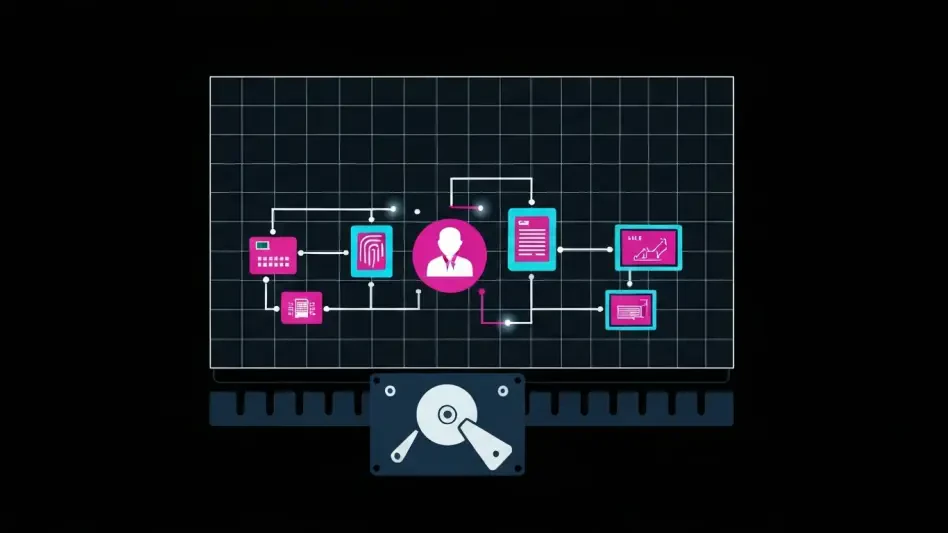In an era where digital threats loom larger than ever, businesses are increasingly finding themselves at the mercy of cybercriminals operating from a shadowy realm known as the Dark Web, a hidden segment of the internet inaccessible through conventional browsers. This underground space has become a thriving marketplace for stolen data—ranging from employee login credentials to sensitive customer financial information—making it critical for companies to act. As cyber breaches grow in both frequency and complexity, the stakes for protecting assets have never been higher. Insights from industry experts, such as Carl Mazzanti, President of eMazzanti Technologies, underscore the pressing need for robust cybersecurity measures. The reality is stark: without proactive steps to monitor these concealed spaces, organizations risk devastating consequences that could undermine their operations, reputation, and bottom line. This discussion delves into the critical importance of staying ahead of threats that originate in the darkest corners of the digital world, offering a roadmap for safeguarding business integrity.
Understanding the Dark Web Threat
Defining the Hidden Danger
The Dark Web represents a concealed layer of the internet, far removed from the surface web that most users navigate daily, and it requires specialized software like the Tor browser to gain access. While this anonymity serves legitimate purposes—such as protecting the privacy of journalists or activists—it also creates fertile ground for illicit activities. Cybercriminals exploit this hidden environment to conduct transactions involving stolen data, including passwords, credit card numbers, and proprietary business information. The very nature of this space, where identities are masked, makes it nearly impossible for companies to detect threats without advanced tools. For many organizations, the Dark Web remains an abstract concept until a breach reveals their data for sale in these underground markets. Understanding this threat is the first step toward building defenses against an enemy that operates in the shadows, often striking before a business even knows it’s under attack.
Beyond its basic structure, the Dark Web functions as a complex ecosystem of forums, marketplaces, and chat channels where illegal goods and services are traded with alarming efficiency. Cybercriminals often use cryptocurrencies to facilitate anonymous payments, further complicating efforts to trace or disrupt these activities. For businesses, the challenge lies in the fact that data stolen through phishing schemes, malware, or insider threats can end up here within hours of a breach. This rapid turnover means that traditional security measures, such as firewalls or periodic audits, are often insufficient to keep pace with the speed of these underground transactions. The anonymity that defines this space also emboldens threat actors, allowing them to operate with little fear of repercussions. As a result, companies must adopt a mindset of constant vigilance, recognizing that the Dark Web is not a distant threat but a very real and immediate danger to their digital assets.
Risks of Data Exposure
When sensitive information is exposed on the Dark Web, the fallout for businesses can be catastrophic, affecting multiple facets of their operations in ways that are difficult to predict or contain. Financial losses are often the most immediate impact, as stolen data can be used for fraud, unauthorized transactions, or ransomware demands that cripple systems until a payment is made. Beyond the direct monetary cost, there’s the looming threat of legal penalties for failing to comply with stringent regulations like GDPR or HIPAA, which mandate strict data protection standards. These consequences can spiral into long-term challenges, as regulatory fines and lawsuits drain resources and divert focus from core business activities. For many organizations, the realization of such exposure comes too late, often after significant damage has already been inflicted, highlighting the urgent need for mechanisms to detect and address breaches at the earliest possible stage.
Equally damaging is the reputational harm that follows a data breach, as trust—once a cornerstone of customer and partner relationships—can be shattered in an instant when personal or financial details are compromised. Customers may turn to competitors perceived as more secure, while stakeholders question the company’s ability to safeguard critical information. This erosion of confidence can have a ripple effect, impacting revenue streams and market position for years to come. Moreover, the Dark Web’s role as a distribution hub means that stolen data can be sold multiple times, prolonging the threat long after the initial breach. Each transaction increases the likelihood of misuse, from identity theft to targeted phishing campaigns aimed at employees or clients. Businesses must grapple with the reality that undetected exposure on these hidden platforms can transform a single incident into a persistent nightmare, underscoring the importance of staying ahead of potential risks.
The Role of Dark Web Monitoring
Early Detection as a Game-Changer
Dark Web monitoring stands as a pivotal tool in the fight against cyber threats, offering businesses the ability to uncover compromised data before it’s exploited on a large scale. Specialized software scans hidden corners of the internet—forums, marketplaces, and encrypted channels—to identify information tied to a specific organization, such as leaked credentials or proprietary documents. The power of this approach lies in its capacity for early detection, often flagging issues long before traditional security systems register a problem. Real-time alerts provide a critical window of opportunity, allowing companies to respond swiftly by resetting passwords, notifying affected parties, or locking down vulnerable systems. This rapid intervention can mean the difference between a contained incident and a full-blown crisis, preserving both financial stability and customer trust in an environment where every second counts.
The significance of early detection extends beyond immediate response, as it empowers businesses to break the cycle of reactive cybersecurity that leaves them perpetually on the defensive. By identifying stolen data in its early stages of circulation on the Dark Web, organizations can mitigate risks before cybercriminals have the chance to weaponize the information through phishing attacks or account takeovers. This proactive stance disrupts the timeline of potential exploitation, often catching threat actors off guard and reducing their window of opportunity. Furthermore, the insights gained from monitoring can reveal patterns in how data is stolen or traded, offering valuable intelligence for strengthening internal defenses. For companies operating in industries with high regulatory scrutiny, such as healthcare or finance, this capability is not just beneficial but essential to maintaining compliance and avoiding punitive measures that could derail operations.
Key Components of Effective Monitoring
Effective Dark Web monitoring hinges on a combination of advanced technology and strategic processes designed to navigate the complexities of hidden digital spaces. Data crawling forms the foundation, involving automated tools that scour obscure networks for traces of compromised information, often sifting through vast amounts of unstructured content to pinpoint relevant threats. This is complemented by data matching, which cross-references findings against a company’s specific assets—think employee emails or client records—to ensure alerts are pertinent and actionable. Real-time notifications are another critical piece, delivering immediate warnings when a potential issue is detected, while expert analysis adds a layer of context, helping to prioritize threats based on their severity and likelihood of exploitation. Together, these components create a robust system that transforms raw data into meaningful insights for swift decision-making.
Beyond the technical elements, the human factor plays an indispensable role in elevating the effectiveness of Dark Web monitoring to new heights. Cybersecurity specialists bring a nuanced understanding of threat landscapes, interpreting alerts in the context of broader trends and specific business needs. This expertise ensures that not every flagged incident triggers a full-scale response, conserving resources for genuine risks while avoiding alert fatigue among staff. Additionally, the integration of monitoring data with other security protocols allows for a tailored approach, addressing vulnerabilities unique to the organization’s operations or industry. For instance, a retailer might focus on protecting customer payment data, while a tech firm prioritizes intellectual property. This customization, underpinned by both automation and human judgment, ensures that monitoring efforts are not just comprehensive but also aligned with the most pressing priorities, fortifying defenses against the ever-evolving tactics of cybercriminals.
Building a Proactive Cybersecurity Strategy
Integrating Monitoring into a Layered Defense
Incorporating Dark Web monitoring into a broader cybersecurity framework marks a significant step toward building a resilient defense against digital threats that are becoming increasingly sophisticated. This approach does not operate in isolation but complements existing measures such as firewalls, antivirus software, and employee training programs. By pairing monitoring with multi-factor authentication (MFA), businesses can add an extra barrier to unauthorized access, even if credentials are compromised and sold in hidden markets. Similarly, enhanced system monitoring can detect unusual activity within internal networks, providing a secondary line of defense when Dark Web alerts indicate potential breaches. This layered strategy ensures that no single point of failure can jeopardize the entire organization, creating a web of safeguards that collectively reduce the likelihood of successful attacks and their ensuing damage.
The synergy of these combined measures fosters a security posture that is both dynamic and adaptable to emerging challenges in the digital landscape. Dark Web monitoring provides the early warning system needed to identify external threats, while internal tools like intrusion detection systems address risks closer to home, such as insider threats or malware that has already infiltrated. Regular updates to security policies, informed by monitoring insights, further refine this approach, ensuring that defenses evolve in step with the tactics employed by cybercriminals. For businesses handling sensitive data—be it customer information or trade secrets—this integration is crucial to maintaining operational continuity and regulatory compliance. The result is a comprehensive shield that not only reacts to incidents but anticipates them, allowing companies to allocate resources efficiently and focus on growth rather than constant crisis management.
Shifting from Reactive to Proactive
The broader trend in cybersecurity reflects a decisive shift from reactive measures to proactive strategies, with Dark Web monitoring serving as a cornerstone of this transformation. Historically, many businesses have operated under a model of damage control, addressing breaches only after they occur, often with significant financial and reputational costs. Monitoring hidden digital spaces flips this paradigm, enabling organizations to anticipate threats by detecting compromised data before it’s exploited. This forward-thinking approach aligns with the increasing sophistication of cyber attacks, where traditional defenses alone are no longer sufficient. By staying ahead of potential risks, companies can disrupt the plans of threat actors, whether it’s through preemptive password changes or targeted security enhancements, thereby minimizing exposure in an environment where timing is everything.
This proactive mindset also cultivates a culture of continuous improvement within organizations, driving them to refine their defenses based on real-world intelligence gathered from Dark Web monitoring. Insights into how data is stolen or traded can inform training programs, helping employees recognize phishing attempts or other common entry points for breaches. Additionally, the data gleaned from monitoring can guide investments in technology, ensuring that budgets are directed toward solutions that address the most prevalent or severe threats. For industries facing heightened scrutiny, such as finance or healthcare, this shift is not merely advantageous but imperative to meet compliance standards and maintain stakeholder trust. Ultimately, embracing proactivity through advanced monitoring positions businesses to navigate the complexities of modern cyber threats with confidence, turning potential vulnerabilities into opportunities for strengthening their digital fortifications.
Reflecting on Actionable Safeguards
Looking back, the journey through the hidden dangers of the Dark Web and the pivotal role of monitoring revealed a clear path for businesses aiming to protect their digital assets. The severe risks of data exposure, coupled with the sophisticated operations of cybercriminals, underscored the urgency of early detection and response. Integrating Dark Web monitoring into a layered defense proved to be a game-changer, as did the shift toward proactive cybersecurity strategies that kept organizations a step ahead of threats. Moving forward, companies are encouraged to invest in specialized tools and expertise, ensuring real-time alerts and actionable insights become part of their daily operations. Strengthening defenses with measures like multi-factor authentication and regular policy updates emerged as practical next steps to fortify resilience. By adopting these safeguards, businesses position themselves to not only mitigate current risks but also anticipate future challenges in an ever-evolving digital threat landscape.








